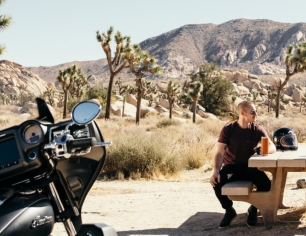Types of motorcycles
There's considerable variety when it comes to the different types of motorcycles, each designed for distinct purposes and riding styles. Cruisers are the most common type of bike, made for comfortable and easy riding. Sport bikes have powerful engines built for speed and agility. Off-road motorcycles may not be street legal, but they cater to riders seeking adventures on challenging terrain. Touring bikes have big engines and are meant for long-distance trips. Scooters and mopeds are lightweight motorcycles, often used for daily commutes and casual riding.
Explore Progressive's editorial standards for Answers articles to find out why you can trust the insurance information you find here.
Understanding the types of motor bikes
The type of motorcycle that's best for you primarily depends on your skill as a rider and how you plan to use your bike. Motorcycle categories are based on rider position, seat height, fairing, weight, engine size/power, suspension, and storage. Here are some popular types of motorcycles and how they function:
Cruisers
Cruisers are broadly defined, smooth-riding, standard motorcycles with middle-of-the-road attributes. They are some of the best commuter motorcycles because of the comfortable, more reclined position and the ability to easily touch the ground with your feet at stops. You can easily customize cruisers and they are a great fit for many riders, including beginners looking for the right bike.
Here are some characteristics of cruiser bikes:
- Relaxed, upright rider position with typically wide handlebars
- Long and frames for stability
- Medium seat height
- Minimal or no fairing
- Engine power may vary from the bare minimum (125cc) to around 1,000cc
Learn how cruiser motorcycle insurance can protect your bike.
Touring motorcycles
Touring motorcycles are built for long trips and are generally much larger and heavier than other types of motorcycles, carrying some of the biggest engines. Their size and power are due to the other distinctive feature of most touring models: extensive storage to account for luggage on long trips. Some touring bikes also include high-tech features like heated seats or other comforts to make long journeys easier.
Some additional touring bike features often include:
- Wider handlebars and lower foot pegs
- Extensive fairing to reduce drag and protect the rider at highway speeds
- Built-in saddlebags
- Windshields and fairings to guard against high winds
- Larger fuel tanks
Find how touring motorcycle insurance can protect you and your bike.
Sport bikes
Designed for speed and agility, sport bikes resemble the motorcycles used in racing. They tend to be lighter bikes with large, powerful engines to maximize their top speed.
Here are some features of sport bikes:
- Sleek and streamlined bodywork
- Low handlebars and rear-seat foot pegs
- Performance breaking
- Adjustable suspension systems
- Aerodynamic fairings
Before you ride a sport bike, get proper protection with sport bike insurance.
Dirt bikes
Dirt bikes are characterized by a high seat placement and long-travel suspension to account for uneven terrain. They usually have small- to mid-size engines but compensate with low weight. Dirt bikes aren't always street legal because they lack lights and turn signals. If you get a dirt bike, you may need to carry it to an off-road site in a toy hauler or other type of trailer.
Here are some additional dirt bike characteristics:
- Knobby tires
- Rugged suspension systems to absorb bumps
- High-performance breaks
- Minimal accessories to reduce weight
- Quick acceleration and torque
Some states may require motorcycle liability coverage if you ride a dirt bike. Get tips for quoting dirt bike insurance.
Scooters and mopeds
Scooters feature a very comfortable, upright riding position, a step-through design, and a low seat height making them ideal for riding in the city and stop-and-go traffic. Some scooters can reach highway speeds but are generally intended for urban travel. They often have some built-in storage and make great commuter bikes.
Here are some traits of most scooters and mopeds:
- Smaller wheels
- Greater fuel efficiency
- Engine sizes are generally in the 50-250cc range
- Automatic transmission for trouble-free riding
- Compact size for easy parking
Due to their lightweight size, scooters and mopeds can be a target for theft. Stay protected with scooter and moped insurance.
Vintage and custom motorcycles
Often more than 30 years old, vintage or antique motorcycles may have historic charm and be valued by collectors. Custom motorcycles have been modified or built from scratch in the owner’s vision and often boast customized paint jobs or alterations to enhance the bike’s aesthetic or upgrade performance.
Find out how to get vintage motorcycle insurance or customized motorcycle insurance.
If you're buying a bike for the first time and still unsure about which type of motorcycle is right for you, find out how you could potentially test ride a motorcycle.
Get a personalized motorcycle insurance policy

Online
Answer easy questions, choose your coverages, and get the protection you need.
Get a motorcycle insurance quote
Call a rep
Speak with a licensed representative who will help you through the entire process.
Call 1-866-749-7436
Enjoy life on two wheels with motorcycle insurance from Progressive
Learn more about our motorcycle insurance offering.










